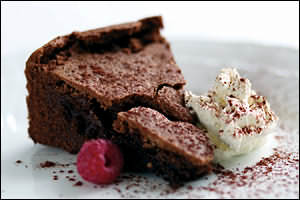CHAMPAIGN, Ill. -- Perhaps men are from Mars and women from Venus, at least in the eating department. When it comes to foods that bring them psychological comfort, men like hearty meals, while women look for snacks that require little or no preparation, though they may cause pangs of guilt. Gender preferences in 'comfort' foods
stem from childhoodThe psychological underpinnings of people's food preferences have been a continuing source of study at the Food and Brand Lab at the University of Illinois at Urbana-Champaign.
While the human craving for salty and sweet foods is well documented, the Illinois lab has found that nearly 40 percent of "comfort-giving foods" do not fall into the traditional categories of snacks or desserts. Instead, they can be classified as relatively natural, home-made, even "healthy" main courses, and include soups, vegetables, pasta, pizza and steak.
"Comfort foods are foods whose consumption evoke a psychologically pleasurable state for a person," reported Brian Wansink, an Illinois marketing professor who heads the lab. Drawing from national survey questionnaires, the lab has concluded that a person's comfort-food preferences are formed at an early age and are triggered, in addition to hunger, by conditioned associations and gender differences.
Men, for example, find comfort in foods associated with meals prepared by their mothers (mashed potatoes, pasta, meat, and soup) rather than from snacks and sweets (excepting ice cream).
But what is comfort for men is work for women. "Because adult females are not generally accustomed to having hot food prepared for them and as children saw the female as the primary food preparer, they tend to gain psychological comfort from less labor-intensive foods such as chocolate, candy and ice cream," Wansink said. Indeed, one study found that 92 percent of self-reported "chocolate addicts" were female.
Many people assume comfort foods are eaten when a person is sad or lonely. "The opposite is often true," Wansink said. "People are more apt to seek out comfort foods when they're jubilant or when they want to celebrate or reward themselves."
But the kinds of foods that give comfort may vary with one's mood, according to the Illinois professor. A person may crave pizza when happy, reach for cookies when sad, and open up a bag of potato chips when bored.
Adults hanker for foods that connect with specific personal events ("My mom always gave me soup when I was sick") or to people in their lives ("My father loved green bean casserole"). Some foods stir vivid reactions when tasted or smelled or come to be associated with personal identity (T-bone steak is "strong and all-American" to many men; tofu isn't). Whatever the trigger, the emotions evoked by food are powerful factors in the human drive to eat -- and overeat.
Wansink will discuss comfort foods on "Top Five," a broadcast of the Food Network, on Monday, July 14, at 10 p.m. Eastern Time. The show was filmed in Wansink's lab and in Eli's Cheesecake factory near Chicago.
Betel nut
Low-fat blues
cacao-chocolate.com
nootropic.com
Vitamins and mood
Pharmacogenomics
Docosahexaenoic acid
Catecholamine depletion
Mood, food and cognition
Nutmeg seeds and anxiety
Bad moods and sick hearts
PUFA deficiency and allergies
Refs
HOME
HedWeb
BLTC Research
The Good Drug Guide
Paradise-Engineering
Utopian Pharmacology
The Hedonistic Imperative

